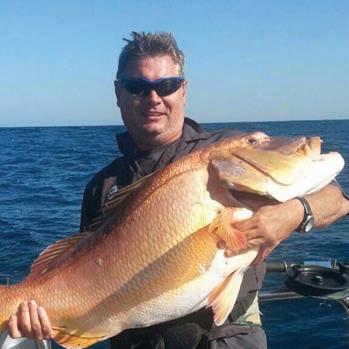
10 minute read
Catching Them Deep

Daniel Hughes, John Luef and Gary Truluck with a 38.3kg red steenbras caught by John at the 2018 Bottomfish Nationals held in East London. The bait used was a dikbekkie flapper.
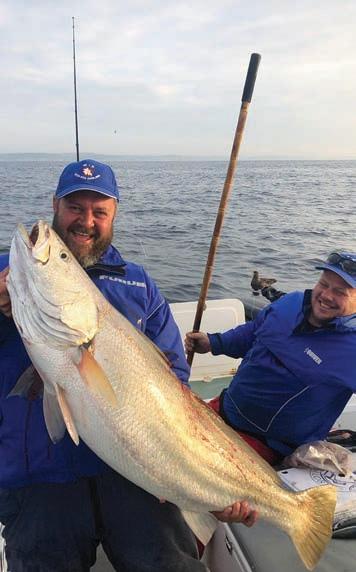
Louis Becker, WP and SADSAA angler, with a beautiful daga salmon caught on 10kg line at the 2019 Bottomfish Nationals fished out of Durban. Louis used a live mackerel as bait.
Advertisement
By Francois Beukes
DEEP sea bottomfish tournament fishing in South Africa is alive and well and is growing from strength to strength. SADSAA tournaments are held regularly (except for during the Covid-19 crisis) and include Nationals, Inter-Provincials, All Coastal and club events which are fished annually at the various venues along our coastline.
These tournaments include categories for Juniors, Ladies and Men and are fished according to IGFA 6kg/10kg line class and SADSAA tournament rules using the SADSAA points scoring system for multiple species.
SADSAA have also introduced catch and release of certain species into competitions. Only fish caught on single hook traces are allowed during these tournaments, therefore limiting the chance of multiple fish hook-ups.
Provincial, SADSAA and Protea colours are also awarded to participants in the sport of bottomfishing. Anglers who aspire to represent their country are advised to join a club and get involved with competitive fishing. Draw up a CV listing all your competitive fishing events and catches as this (in addition to you competing in a specified number of inter-club, provincial and national tournaments), is a requirement for selection.
In this article I’ve given some details of various aspects of competitive bottomfishing for those who are keen to participate.

Brandon Aspden shows off his 6.7kg Scotsman caught using a soft bait of soldier fillet. The fish was caught on 10kg line at the 2019 Bottomfish Nationals and is a Zululand record.
THE WEAK LINK
SADSAA have made a ruling in line with IGFA rules that a minimum of 5 metres of line of the line class to be fished in the various tournaments is required. This is known as the weak link. Braid or any stronger line may be used as backing. In reality it is advisable to use more line than this if the angler would like to claim a record for any specific fish caught, as a line sample is usually requested for testing and 5 metres is not enough.
Anglers can opt to fish totally with the line class as requested by the tournament or use the weak link. Anglers usually opt to use the weak link when angling takes place in relatively deep water or strong currents due to the stretch in mono line. The backing is usually braid which gives the angler a better chance of feeling the bites.
DOUBLE LINE
If a double line is used it must meet the following specifications: 1. A double line must consist of the actual line used to catch the fish. 2. Double lines are measured from the start of the knot, braid, roll or splice making the double line to the farthermost end of the knot, splice, snap, swivel or other device used for securing the trace, leader, lure or hook to the double line. In all line classes up to and including 20 lb (10kg), the double line shall be limited to 15 feet (4.57m). The combined length of the double line and leader shall not exceed 20 feet (6.1m).
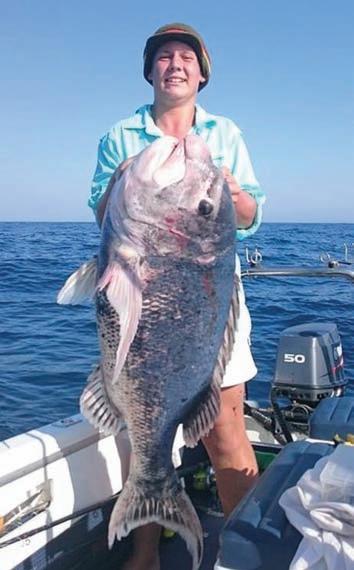
Seth van den Berg, a junior SADSAA angler, was thrilled with this 23.4kg black steenbras caught on 10kg line at a Natal Bottomfish Zonal event. Seth was using a live bait.
Double lines are usually used by the angler to improve the knot strength when tying mono to leader or braid.
LEADERS
If a leader is used it must meet the following specifications: 1. The length of the leader is the overall length including any lure, hook arrangement or other device. The leader must be connected to the line with a snap, knot, splice, swivel, or other device. Holding devices are prohibited. 2. There are no regulations regarding the material or strength of the leader. In all line classes up to and including 20 lb (10kg), the leader shall be limited to 15 feet (4.57m). 3. The combined length of the double line and leader shall not exceed 20 feet (6.1m).
Leaders are mostly used to help prevent line breaks close to the trace when fighting a fish on a rocky bottom or even by chafing off on the fish itself.
BASIC KNOTS
There are numerous knots that anglers can use and most anglers have their own preferences. If you are using knots that you are comfortable and happy
with, continue to do so.
In order to fish confidently you need to know you have good, solid knots in linking the following areas: Leader or line to hooks or swivels, leader or line to line, leader or line to braid and double line knots. All these knots are demonstrated in detail on You Tube.
Always remember to wet any knot (usually with saliva) before pulling it tight as this lubricates the knot and will prevent heat from friction which may damage the structural strength of the knot.
With the old saying of “keep it simple”, the following basic knots will get you by ...

Uni knot
Uni knot
The Uni knot shown above is generally used to tie leader or line to hooks or swivels. For step by step instructions on tying it read Paul Borcherd’s article which appeared in the July 2014 issue of SKI-BOAT.

Double Uni knot
Double Uni knot
The Double Uni knot shown above is used mainly to join leader or line to line. For step by step instructions on tying it read Paul Borcherd’s article which appeared in the July 2014 issue of SKI-BOAT.

Albright Special
The Albright Special shown above is a good knot to use when tying braid to leader; you can also double the braid. For step by step instructions on tying it read Paul Borcherd’s article which appeared in the November 2014 issue of SKI-BOAT. It’s available on issuu.com at <https://issuu.com/sheenacarnie/ docs/skiboat_201411/37>.
Finally, when doing a double line there are generally two knots to use — either the Bimini Twist or the Spider Hitch.
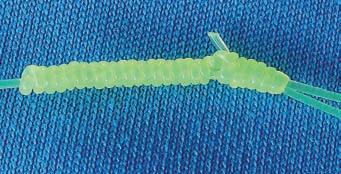
Bimini Twist
For step by step instructions on tying the Bimini Twist read Paul Borcherd’s article which appeared in the March 2015 issue of SKI-BOAT. It’s available on issuu.com at <https://issuu.com/sheenacarnie/docs/ skiboat_201503/44>.
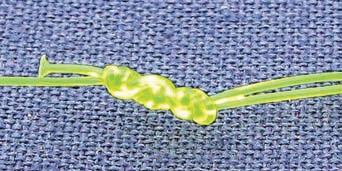
Spider Hitch
I much prefer the Spider Hitch as it is so quick and easy to make and is an extraordinarily strong knot, especially when you’re making it on a boat out at sea. For step by step instructions on tying the Spider Hitch read Paul Borcherd’s article which appeared in the January 2015 issue of SKI-BOAT. It’s available on issuu.com at <https://issuu.com/sheenacarnie/docs/ skiboat_201501/40>.
TRACES
The most common question asked, is how long your hook and sinker line should be and that is difficult to answer as there are quite a few variables to consider including area, depth, and target species.
Generally when we’re shallow fishing (less than 20m deep) relatively short hook and sinker lines are used — approximately 12” for hook and slightly shorter for the sinker as most fish are hooked close to the bottom. As you go deeper this is lengthened to up to 36” and even longer with a longer sinker trace.
In some areas such as the KZN coast anglers generally use much longer traces, especially for dagga kob and geelbek. When certain of the larger species such as black and red steenbras are targeted using live baits, generally a longer and thicker trace is used.
It is important, though, that you prepare all your traces and tackle for the various fish you want to target before a fishing trip and keep them in readiness in a trace bag. During competition angling you need to maximise the time you’re actually fishing and do not want to be making traces on the boat while you could be catching fish.
The same applies to having a few made-up trace rigs containing the required length of weakest link joined to your leader. The trail of thought behind this preparation is that if you miss a drift or a down, you miss the opportunity to hook a fish and that fish could be the one that makes all the difference either as a species multiplier or added weight overall.
Of course even if you’re not fishing competitively you want to maximise your time on the water so it always pays to prepare in advance.
BAITS AND BAIT PRESENTATION USED FOR DIFFERENT SPECIES
Bait and presentation are both especially important. The more natural a bait presentation, the better your chances of a strike. There are a lot of different types of baits that can be used, and usually but not always you can use a certain bait or presentation to target a specific species. Some of the more common baits are explained below.
SQUID
Squid is a very versatile bait and almost all deep sea anglers will use this bait in some way or another. Squid is most effective when fresh, but that’s not always available.
To prepare your squid defrost it, cut it open along the length, then skin it and wash it. Then cut the squid into thin strips or elongated triangular strips and weave it onto the hook. Always try to leave a long dangling strip below the hook, as this moves about in the current and attracts attention.
Always make sure your hook point is sharp and well exposed to avoid missing your bites. Do not discard the squid head as this is also an extremely good bait.
Squid is also commonly used with pilchards as a “mixed grill” bait. Anywhere along the coast a nice strip of squid woven onto the hook and a thin fillet of pilchard tied onto the outside of the squid with cotton will the trick. Coppers, Miss Lucy’s, soldiers, scotsman and dageraad all love this bait.
PILCHARD
Pilchard is the most versatile bait and almost all species of fish will take it freely.
This bait can be used in many ways and presentations. The pilchard can be used whole, where the hook is put through the lower jaw between the eyes and out through the top of head or even just hooked through the eyes. This is extremely successful when targeting geelbek.
Pilchard can also be sliced and tied onto the hook with cotton or used with most other baits as a mixed grill.
A very popular presentation is to cut the head and tail off, then to slice the pilchard lengthways almost through, turn the pilchard inside out and wrap it around squid, fish fillet or any other bait put onto the hook. This is then tied on nicely with cotton.
LIVE BAIT
When targeting geelbek, dagga salmon, black steenbras, coppers or rock cod, among other species, sometimes the only bait they want is a live bait. Most small fish can be used for this, including mackerel, shad, maasbanker, big eye, steintjie, butterfish, dikbekkie or carpenter. For the best results use the bait straight after it’s been caught.
Live bait can be caught using Yozuri bait rigs which are available at all tackle shops.
The live bait can be rigged up by pushing the hook into the mouth and up through the head just below the eyes or pushing the hook through the fish just above the spine. One of the live bait’s lateral fins could also be cut off; this will cause the bait to swim haphazardly also putting out distress signals which will attract other fish.
A large hook, preferably a 10/0 or bigger, can be used on a lengthened snoot line trace to give the bait more movement.
FLAPPERS
If a live bait fails, sometimes the fish will take a flapper. Flappers are small fish that are prepared by slicing down on each side of the dorsal fin and removing the backbone and tail. You can then squeeze or bash the head of the bait to soften it and release some of the fish scent that will be picked up by your target species.
Again a 10/0 or larger hook is pushed in through the mouth and up between the eyes of your bait.







